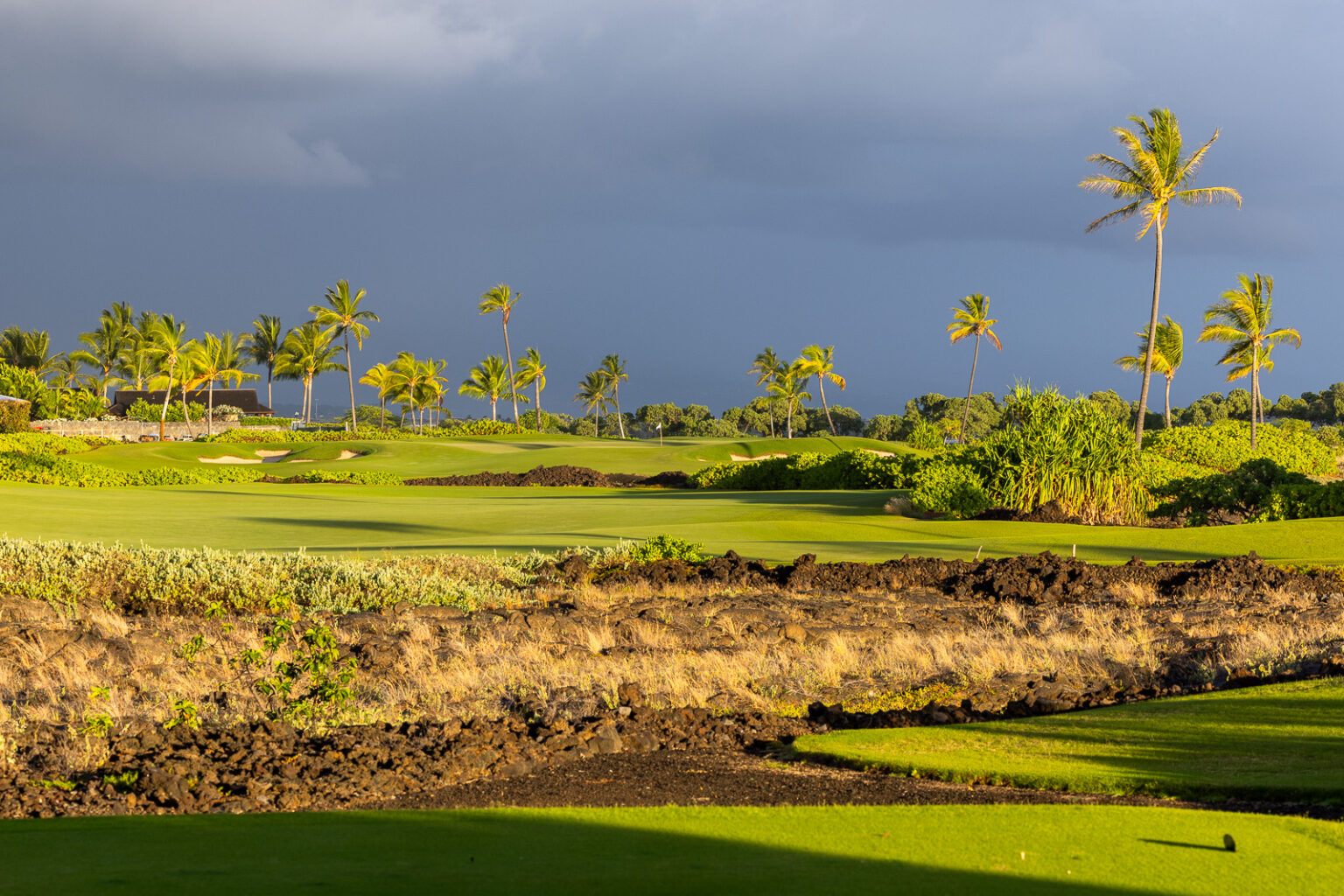While golf architect Rees Jones may be best known for his renovation work as the “Open Doctor” he’s had a number of high-profile designs of his own over the years.
I’ve played a handful of them.
There’s the extremely-private and challenging Atlantic Golf Club in Bridgehampton.
The over-the-top engineering marvel that is Cascata outside Las Vegas.
Or one my personal favorites of recent memory, the Oconee Course at Reynolds Lake Oconee.
But what happens when you give such an experienced architect some of the best oceanfront land possible, and say “build me something special.”
You get Kohanaiki, which might just be the best golf course (and club) you’ve never heard of.
What is Kohanaiki?
Rees Jones initially envisioned the Kohanaiki Course in Kona, Hawai’i in 2008, while he was renovating the Mauna Kea course down the street.
It then opened for play in the Spring of 2013.
Kohanaiki is a bit unique in that they built out nearly all of the (extensive) club amenities well before they’d established most of the real estate around the 450-acre property.
Kohanaiki is essentially an extremely high-end golf club and residential community.
You have to own property or be a “Hale Club” member in order to have a Kohanaiki membership, and let’s just say, it’s not exactly cheap to get in.
But once you are?
Members and guests are treated to what is undoubtedly one of the most spectacular club experiences in the world.
Here’s my post covering everything you need to know about Kohanaiki Club, but this one is just about the golf course 🙂
Fortunately, there’s plenty to cover there as well 🙂
First Impressions of the Kohanaiki Golf Course
It’s not very often I’m speechless when pulling up to a golf clubhouse, but the clubhouse at Kohanaiki left me with my jaw wide open.
There’s a turnaround that is mostly full of golf carts, as that is the preferred method of transport around the property.
Directly ahead is the entry to the nearly 70,000 square foot clubhouse. There’s a massive outrigger canoe as a centerpiece, and directly beyond that is a reflection pool overlooking the property and Pacific Ocean.
It’s stunning.
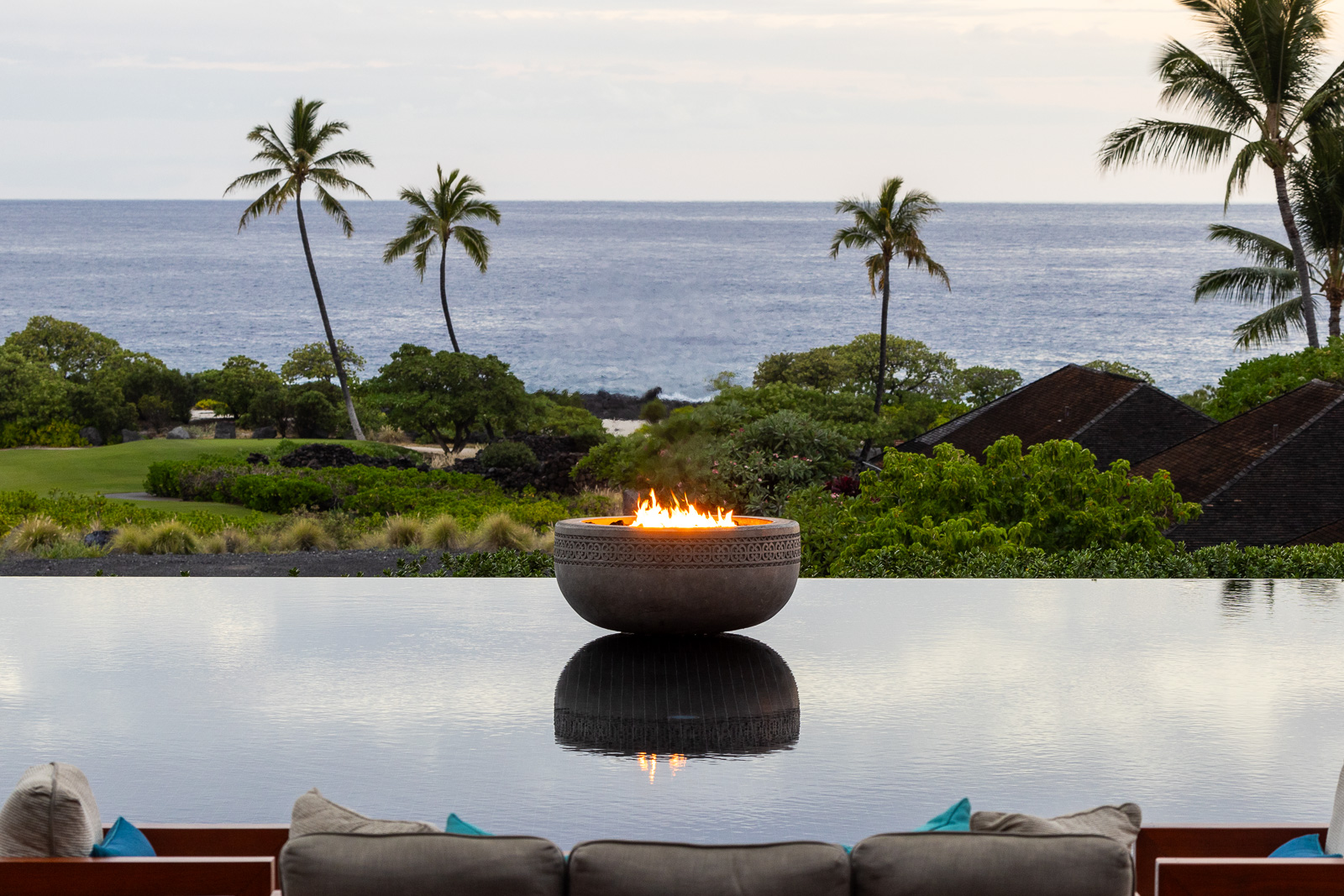
But we’ll save the rest of that tour for another time.
To the left of the clubhouse is the pro shop.
Once you’ve got your cart, you’ll meander down a path until you hit the practice green and driving range.
I’ve seen some impressive driving ranges in my day, but this might be the most perfect range I’ve ever seen.
Not a single blade of grass is out of place.
And I’m not lying when I say this, there were a handful of times as I was exploring the club that I literally reached down and felt the grass, convinced that it couldn’t be real.
It obviously is.
The range is dual-sided, with the far side available solely for member use.
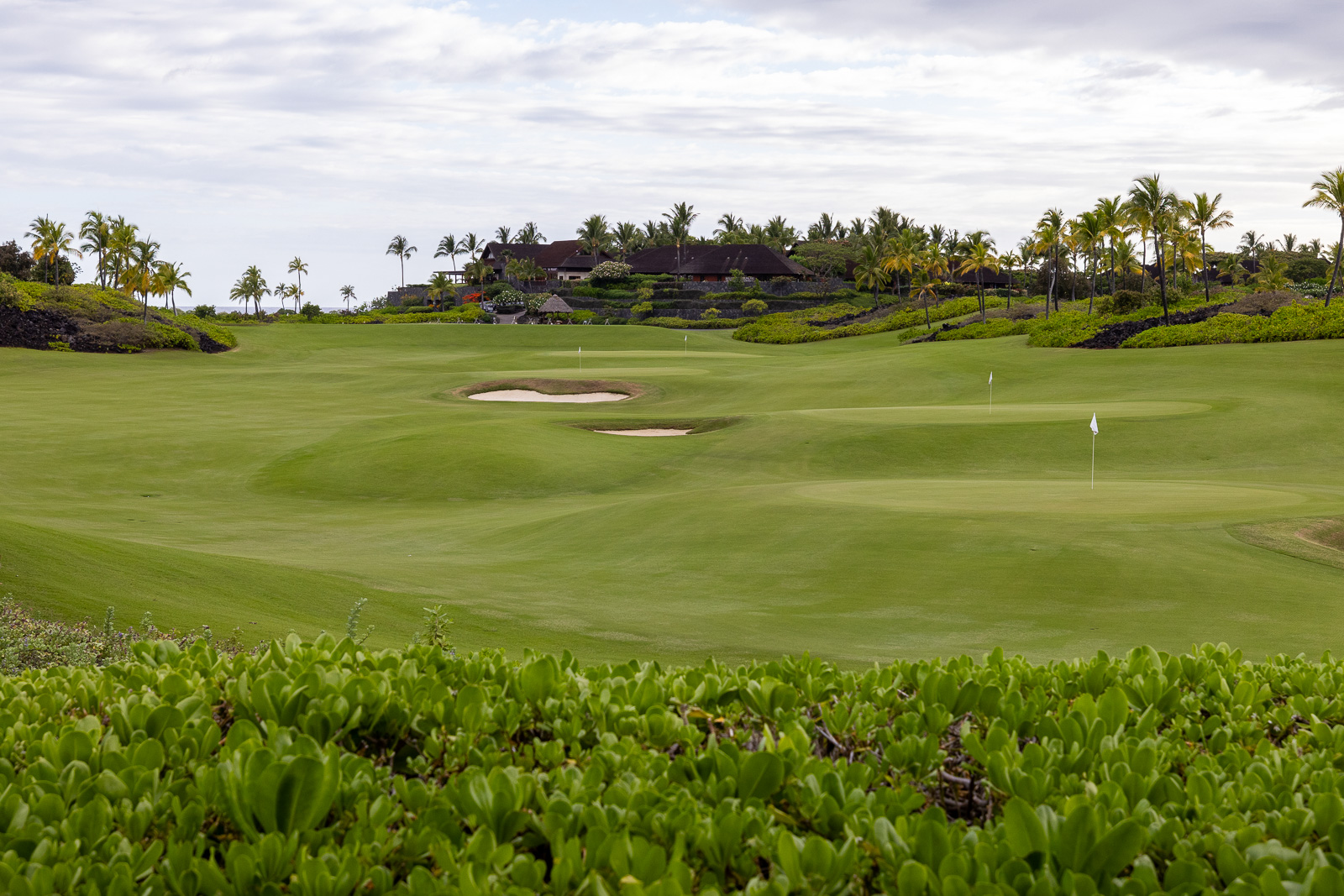
There are 4 practice greens at different distances, and they’re maintained to the point I said “I feel like you should turn this into a par 3 course!”
To which their Director of Golf, Lehua Wise, responded “We do!”
Of course, they do.
The History of the Land at Kohanaiki
Real estate developers aren’t always known for their sterling reputation when it comes to preserving the history of the land they develop.
We’ve seen this over and over again both in Hawaii, and across many other tropical island destinations.
But Kohanaiki is different.
The developers worked in tandem with local cultural leaders and lineal descendants of the land, to ensure that everything about Kohanaiki both preserved and honored the history of the sacred land.
One of the most obvious ways you see this are in the 14 “Ahu” or shrines, across the property. You’ll find these built into both the course landscape, as well as individual properties as well.
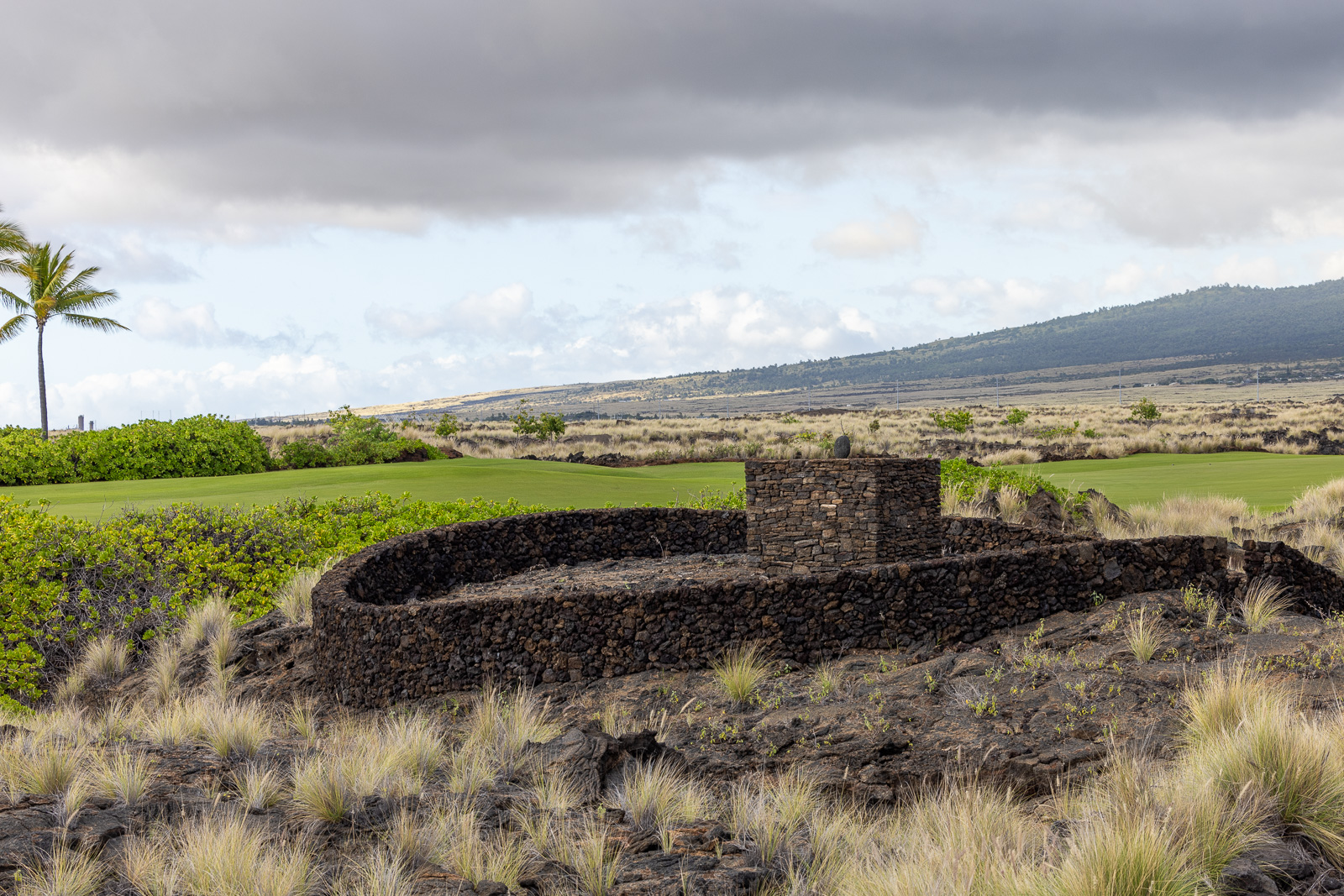
On 14, you’ll find a lava rock bunker which is one of the most unique hazards in golf. But it’s not just for aesthetics. This is another sacred spot on the land, and the only people who are allowed to enter are those who have been blessed and have undergone a special ceremony.
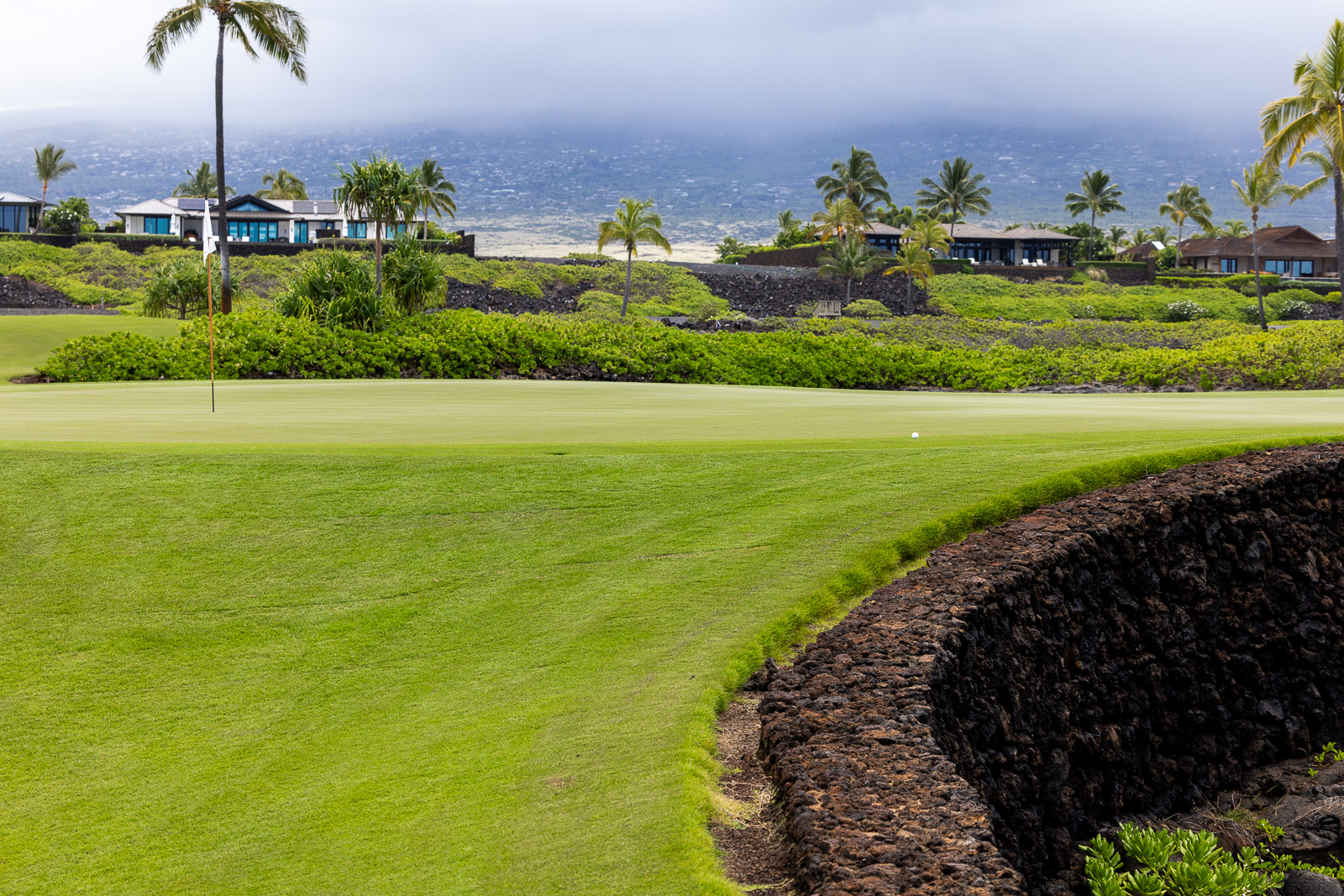
Everywhere you look on the property you’ll find examples of the history. Whether it’s rock walls, Ahu, Lokoi’a (fish ponds), or even an ancient Donkey Corral – it’s this local history that is part of what makes the Kohnaiki experience so special, and unique in the world of golf.
Even the logo stems from a petroglyph that was found on the property. Your initial reaction might say “surfer” but it’s actually a fisherman casting a net.
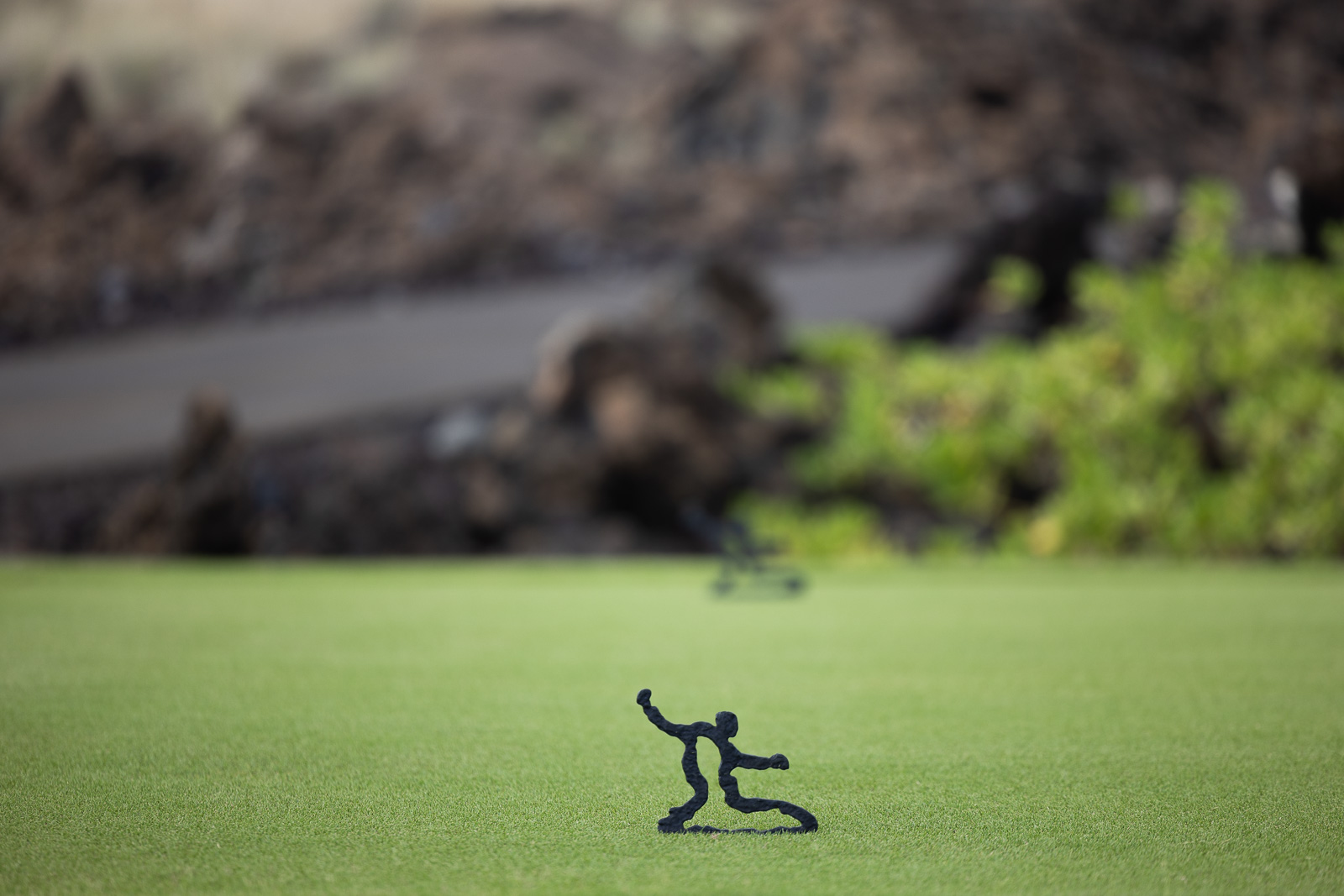
The Front 9 of Kohanaiki Golf Course
When it comes to the golf course itself, the line I’d heard before I arrived is that they have more oceanfront holes than any course in Hawaii, with 6.
I was excited to see these along the back 9 of the course, but it had me curious as to what the experience would be like on the front 9.
Being a real estate community, I was concerned the interior holes wouldn’t live up to the drama of those on the ocean.
Good news: Those fears were unfounded.
The opening hole gives you a great introduction to what you can expect on the course.
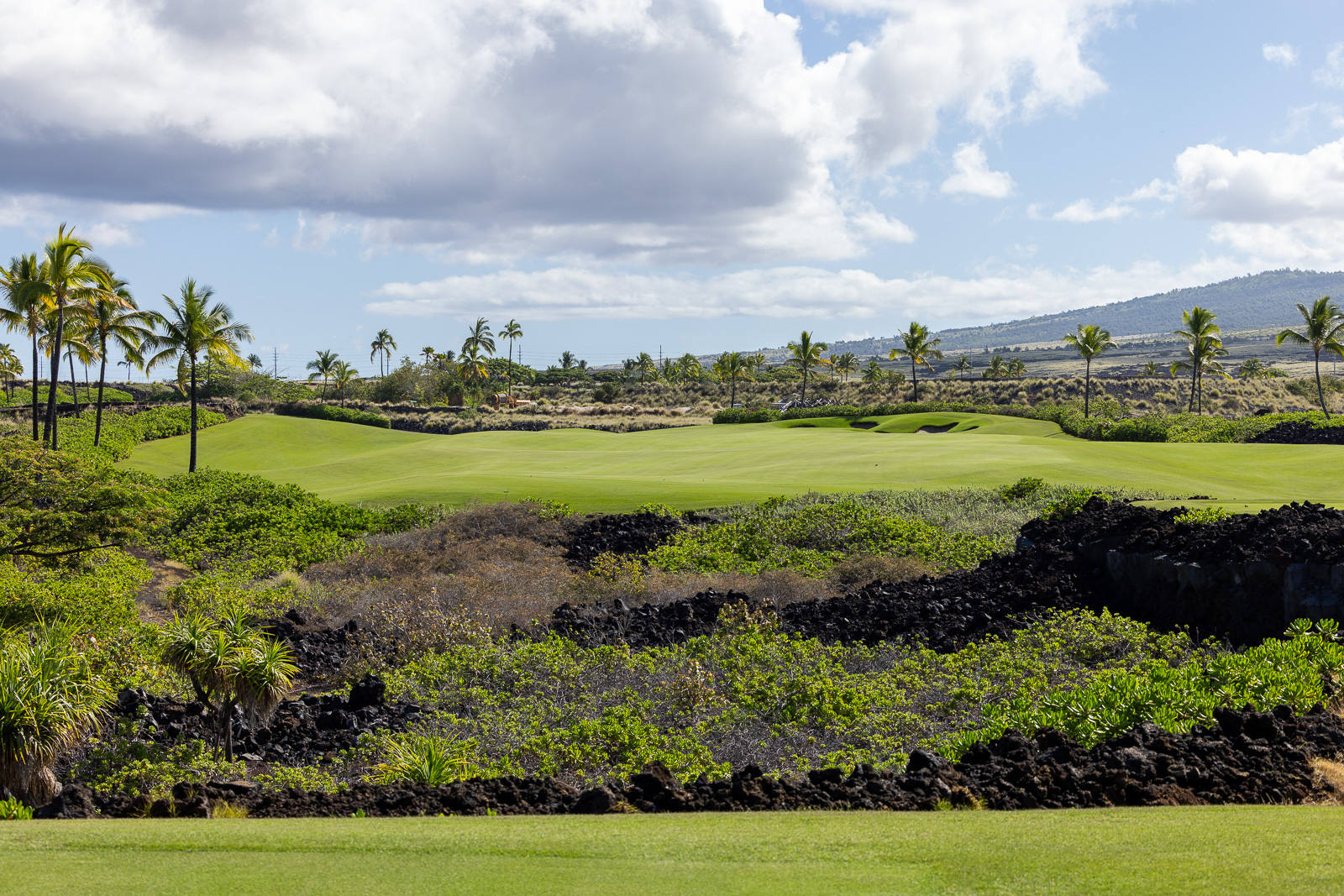
The fairways are very generous, but as you might expect with a Rees Jones course, you don’t want to mess with the surprisingly deep fairway bunkers.
It’s honestly, exactly the kind of course I like and that suits my game.
Wide fairways, technical and exacting approach shots, and very fun and diverse greens.
I always enjoy courses the most that give you a little room off the tee, and provide their defense with greens and approaches. This is especially true for a destination course in a place like Hawai’i.
But that’s not to say you can’t find yourself in trouble off the tee.
Considering this was the first round I’ve ever played in Kona, the immediate thing I noticed and was taken aback by is the lava rock.
It’s everywhere, and it provides one of the most compelling and fun visual experiences of any golf course I’ve played.
There are ancient lava tubes that scatter the course, and as you’ll see when we talk about the back nine, the lava is very much in play and is built into the DNA of the course and property at Kohanaiki.
If you go too far right on that first drive, you’ll see just how brutal it can be.
Despite being inland, the opening 9 is full of fun and diverse holes.
The par 4 3rd hole heads slightly uphill directly towards Hualalai, the mountain that Kohanaiki sits at the base of.
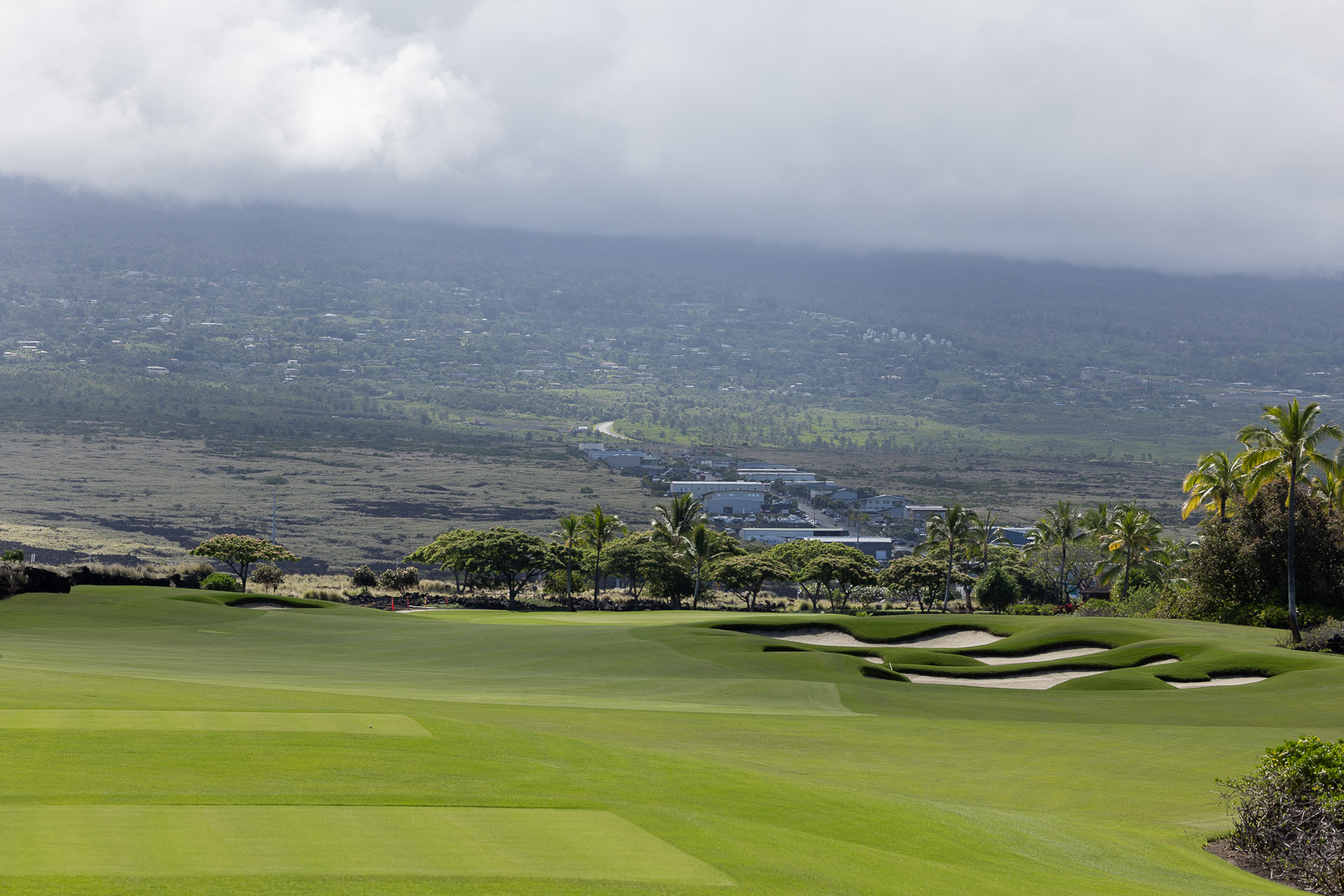
It’s a challenging hole, and the feeling of watching your drive climb up against the backdrop of the mountain is one of the most fun shots on the course.
The 4th is another favorite that takes you downhill and lets you hit just about any club you want off the tee.
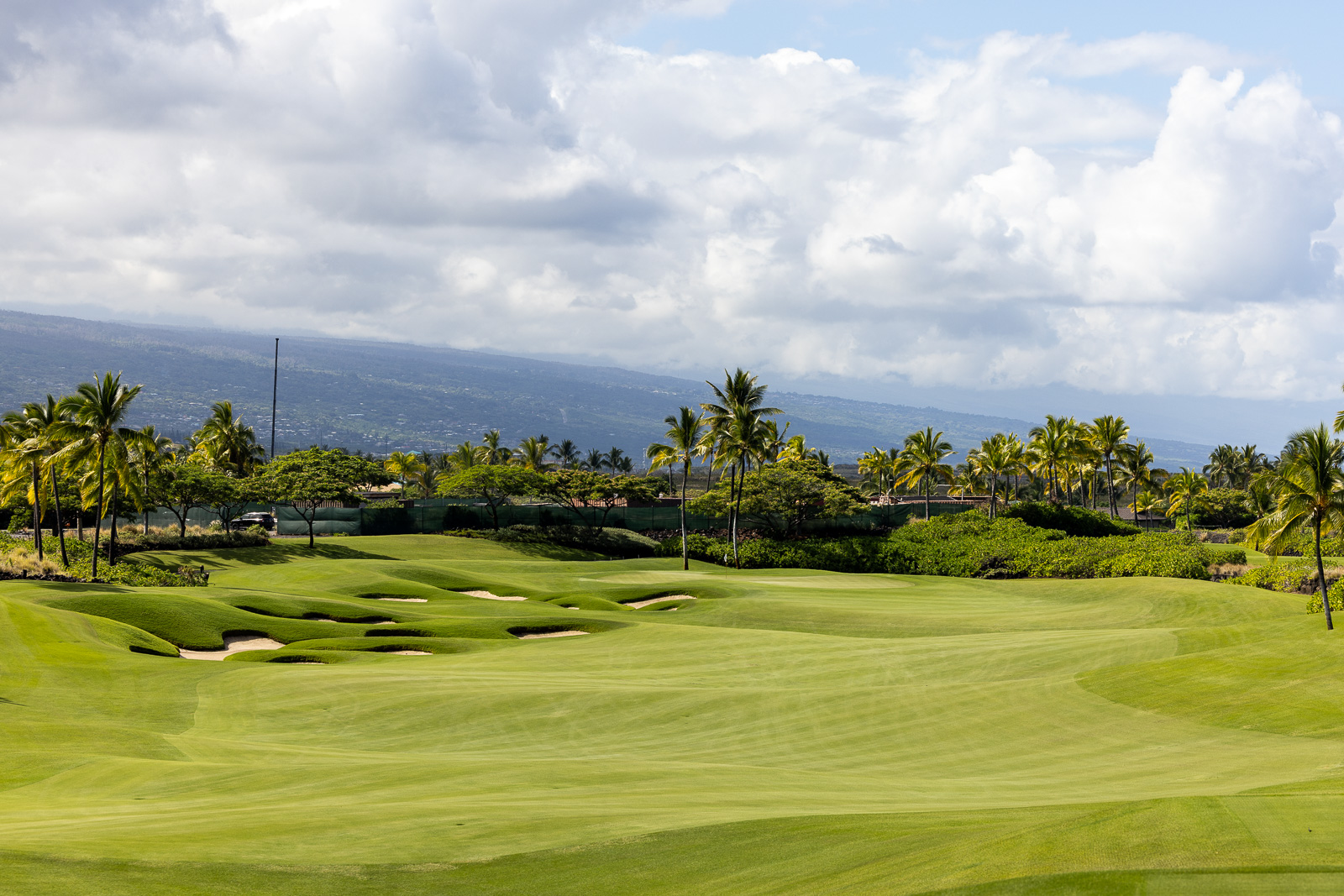
There’s a deceptive gap between the end of the fairway and the green, so if you take too much club, you could find yourself in a bit of no man’s land with a touchy approach.
On the 5th hole, Jones shows how even holes away from the water can still be super unique. It’s a longer par 3 that was carved out of lava rock, which surrounds the entire green.
During my time there I asked 4 people what their favorite hole was. I got 4 different answers, which is always a sign of a good course.
This was one of the answers.
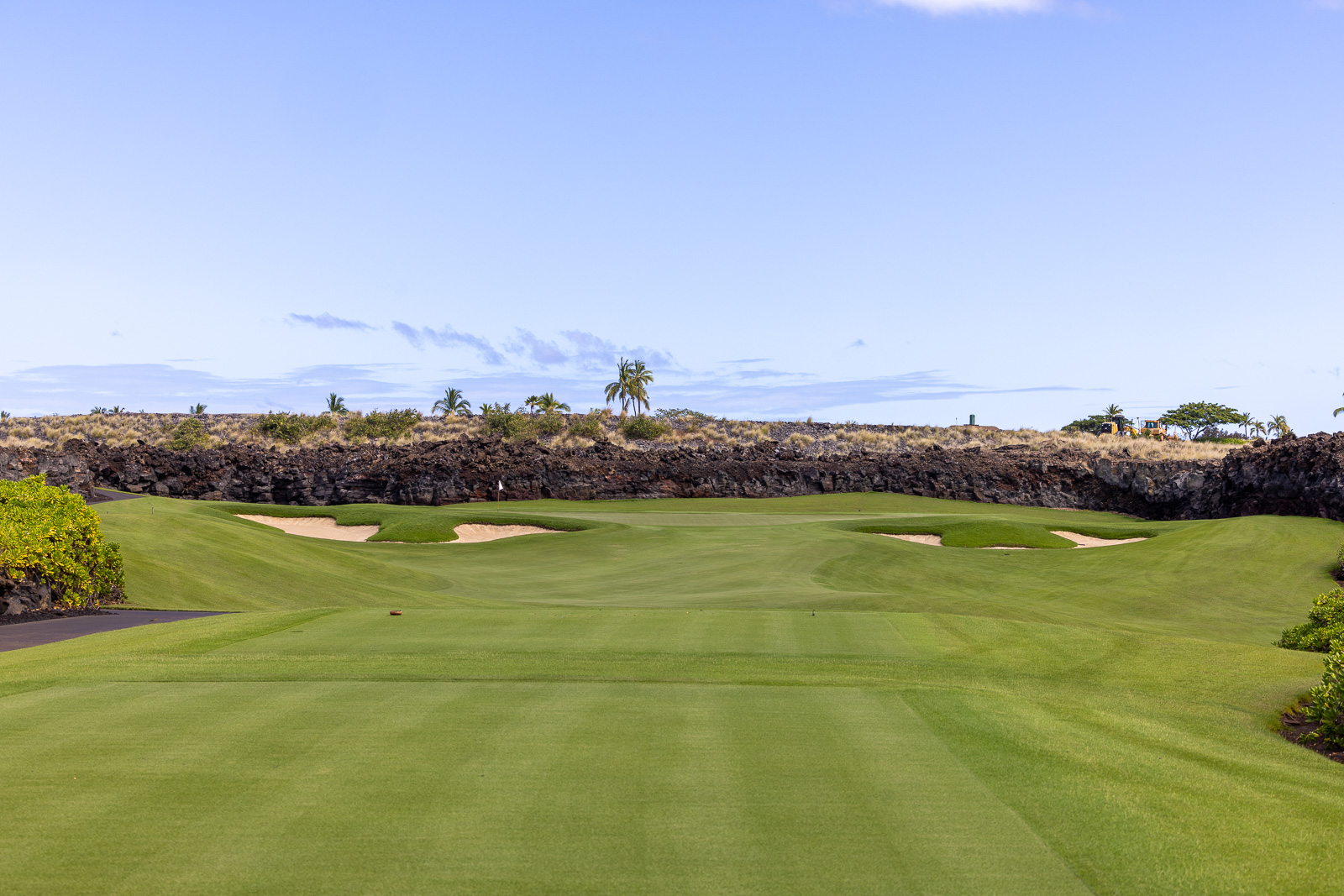
On 7 and 8, you get the only water that’s featured on the front 9 – and it’s done really well.
You’ll need 2 precise shots on the par 4, 7th. One avoiding the fairway bunker, and then an approach over the water – which can get really dicey when there’s a tucked right pin.
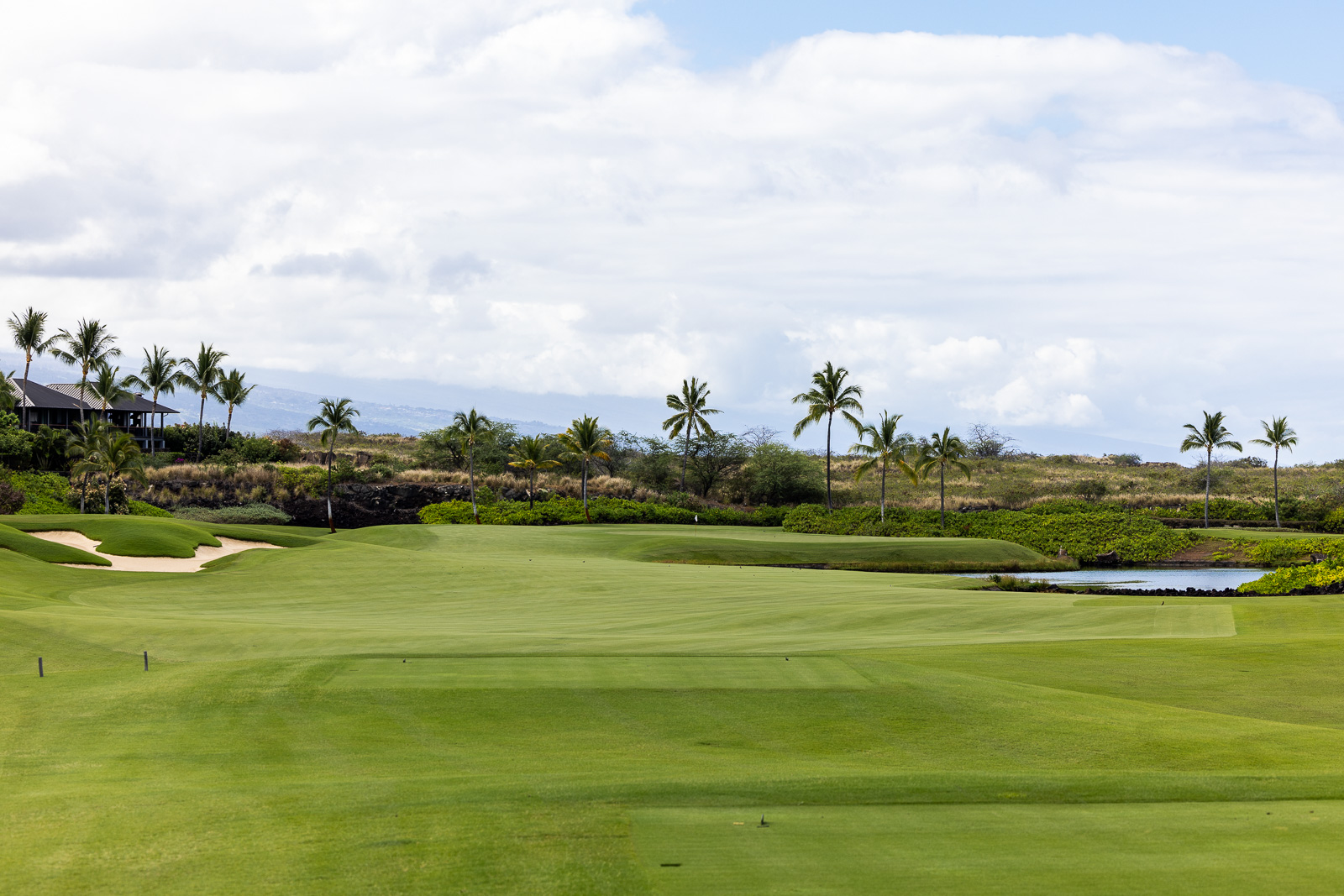
The same lake meanders over to 8, where you’ve got a wonderful risk/reward tee shot.
If you’re a long hitter and want to play aggressively, you can pick your line over the water and give yourself a chance to get home in 2.
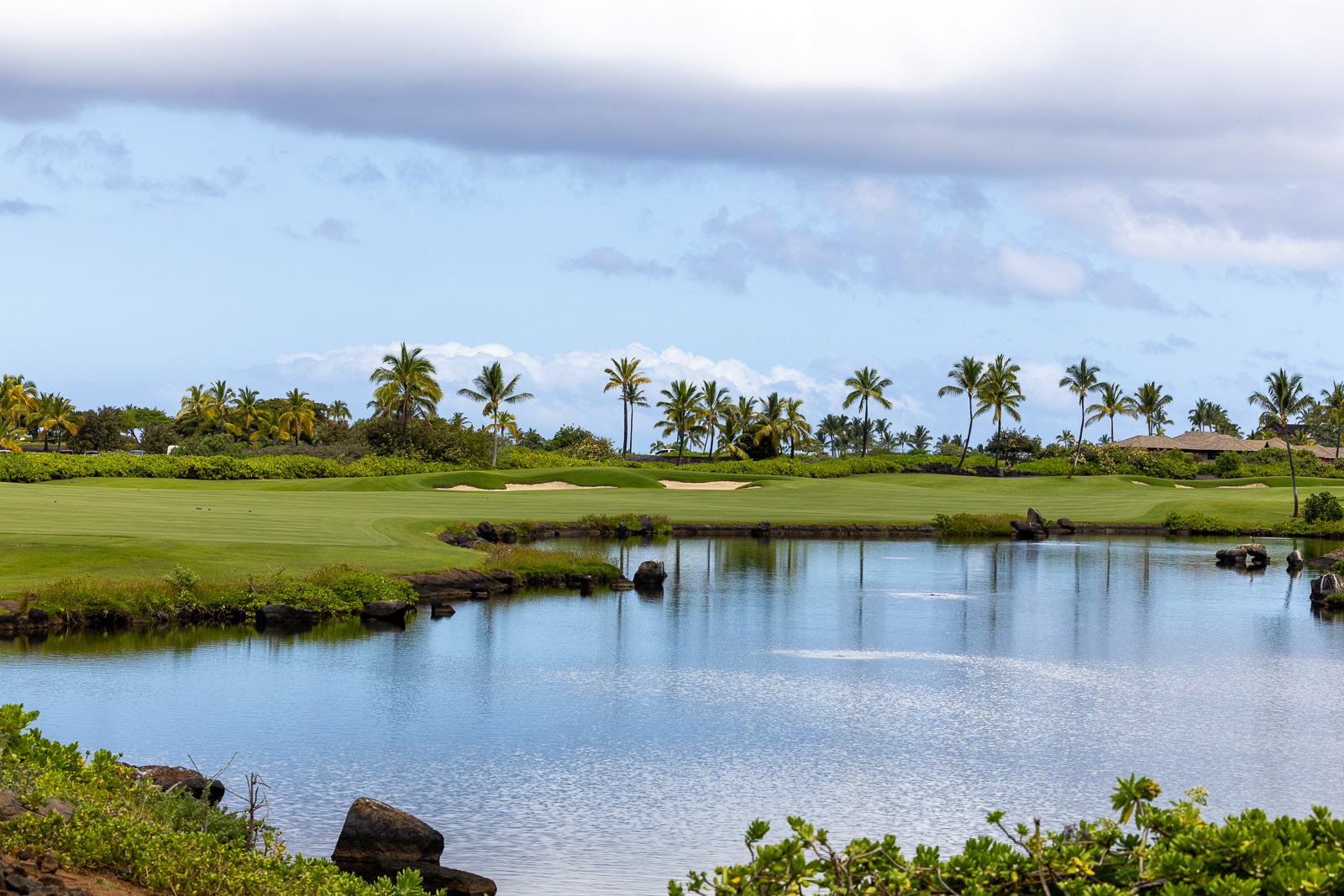
Or you can drive up the left, then play strategically on your layup and approach distances to make your birdie that way.
The 9th is one of my favorite holes on the course. It’s a short par 4 that will play tricks on you. The cross fairway bunkers are further away than they look, so the safer play is down the left-hand side, despite giving you a trickier uphill approach.
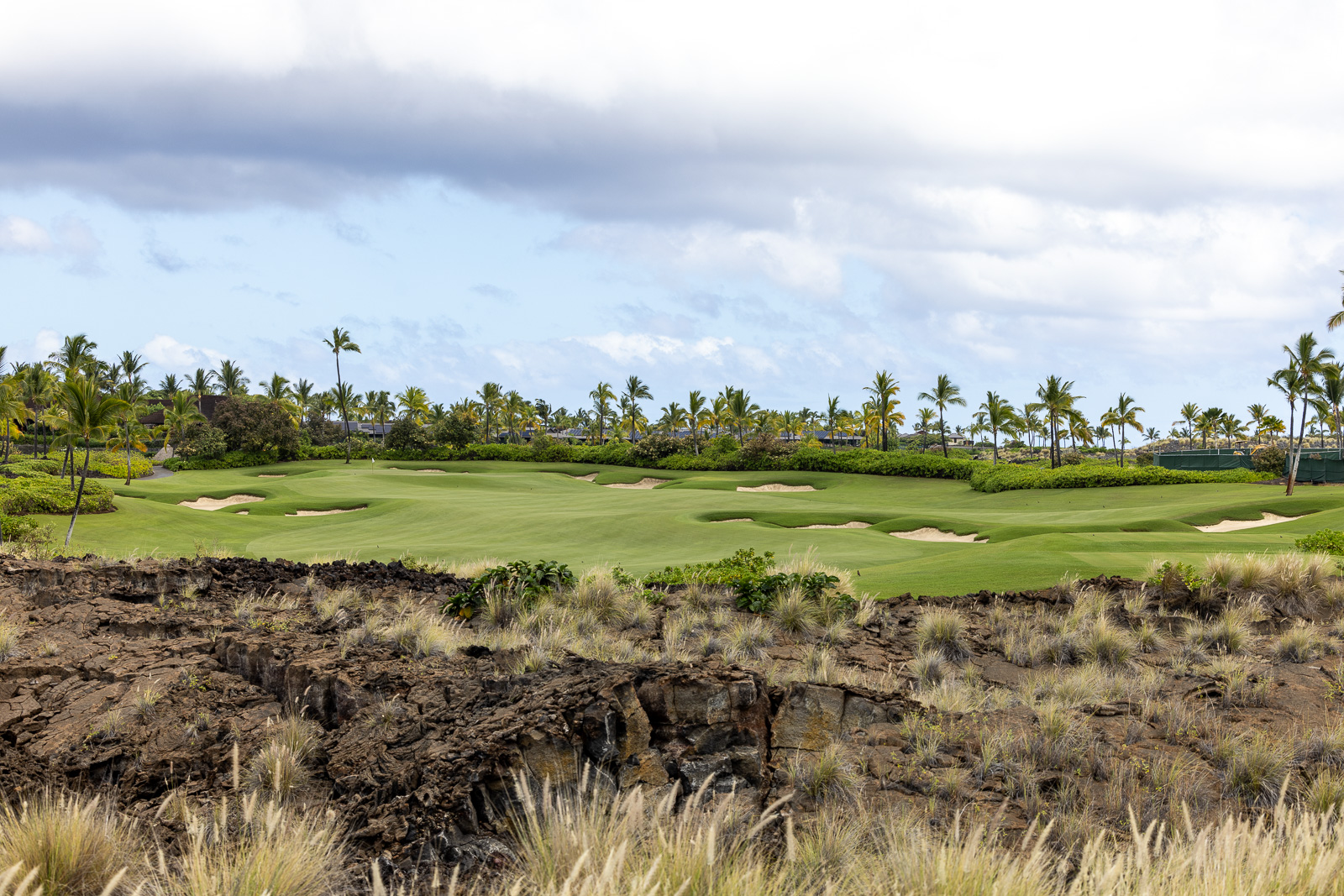
The Back 9 of Kohanaiki Golf Course
The 9th hole brings you back to the clubhouse, and then 10 goes off near where you teed off for the first hole.
This is another dramatic tee shot over lava and the “organic” farm. The natural land features will really start to play more of a role across the back 9 of the course.
The green on 10 is shallow and has lava directly behind it, which makes for a really cool visual.
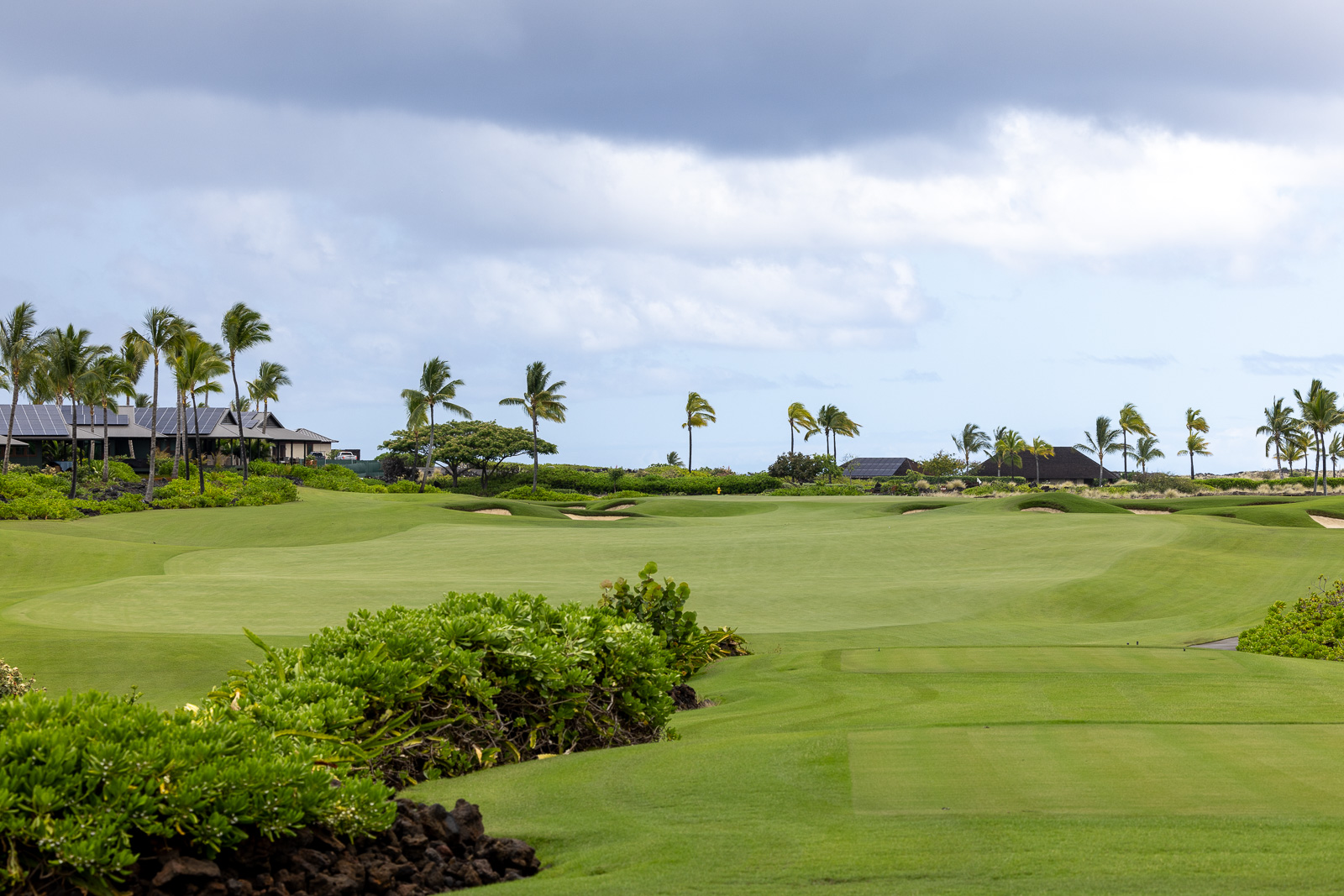
I’m a sucker for shorter par 4s, and you’ll find another one at 11.
It’s drivable for big hitters, but the rest of us have to play smart. There are deep greenside bunkers waiting to swallow up any ball that doesn’t quite make it. But a safe drive down the left leaves you with an optimal angle for your approach, and one of the best birdie opportunities on the course.
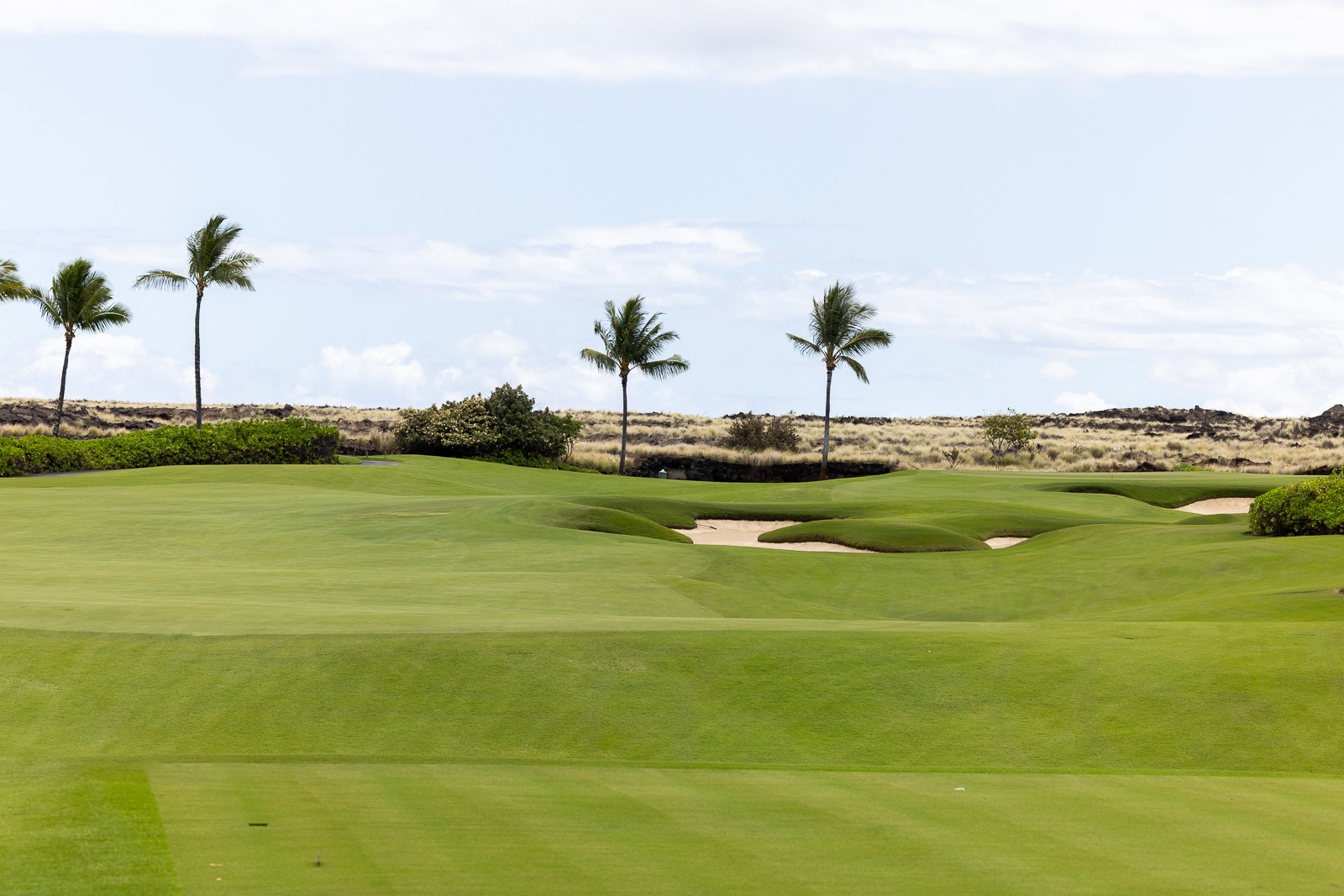
Before playing, I’d heard the first 12 holes were pretty manageable difficulty-wise, but at 12, everything changes.
While the first 2/3 of the course certainly can be challenging, there’s no denying things ramp up on 12.
Director of Member Experience (and unofficial Kohanaiki Mayor) Marty Keiter once called the walk from 11 green to 12 tee “the best left-hand turn in golf.”
While the 4th at Bandon Dunes gets my pick for best right-hand turn, there’s no denying the visual feast that the 12th hole provides.
The 12th is the signature hole at Kohanaiki, and in my opinion, it may be the toughest as well.
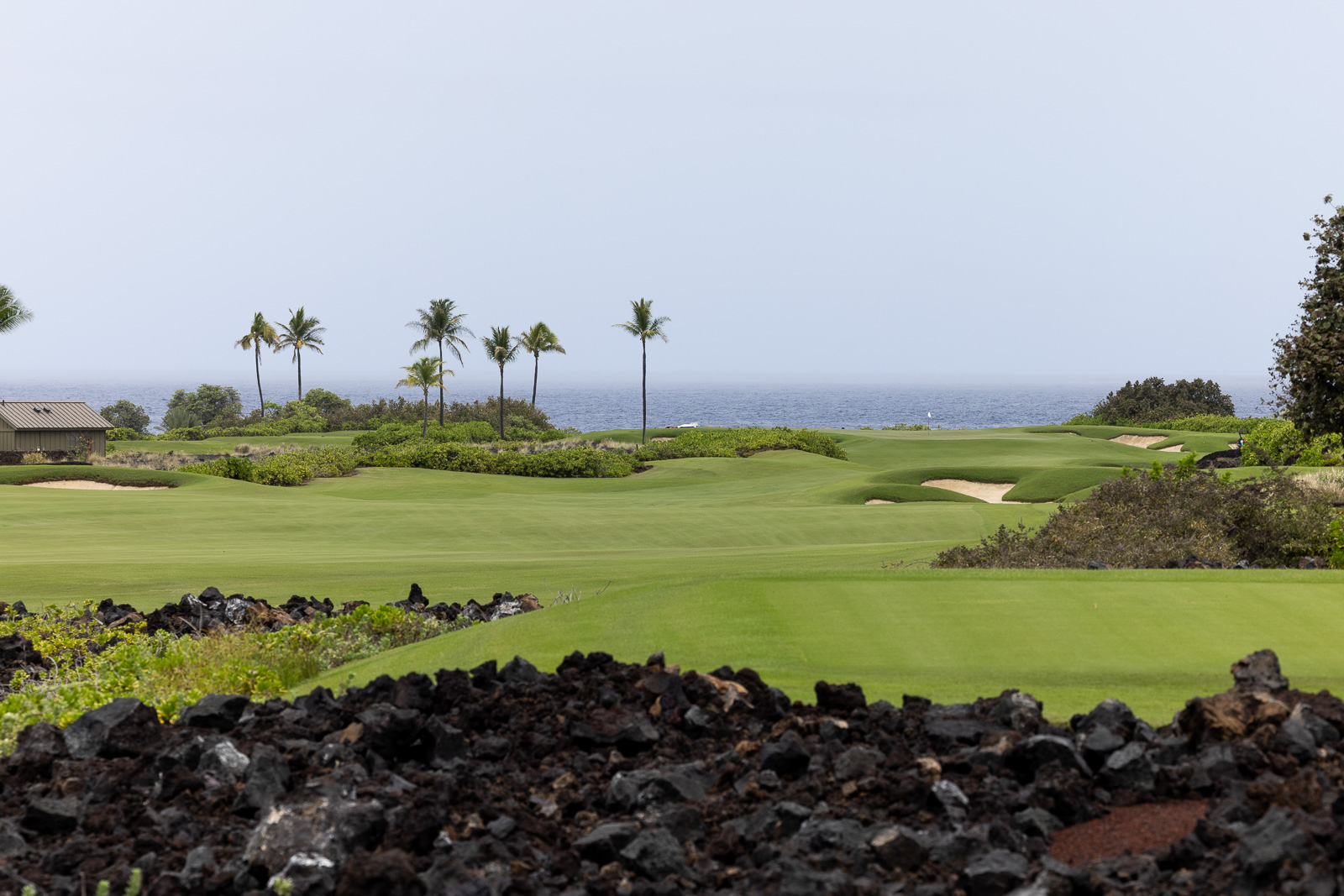
It’s a long par 5, that plays directly into the winds blowing off the Pacific.
It features all of the hallmarks of the course within one hole: lava rock, deep bunkering, a challenging approach, and a difficult green.
Not to mention you have to do all of this while trying not to get distracted by the view.
On the par 3, 13th you start to get a sense that things aren’t going get any easier from here.
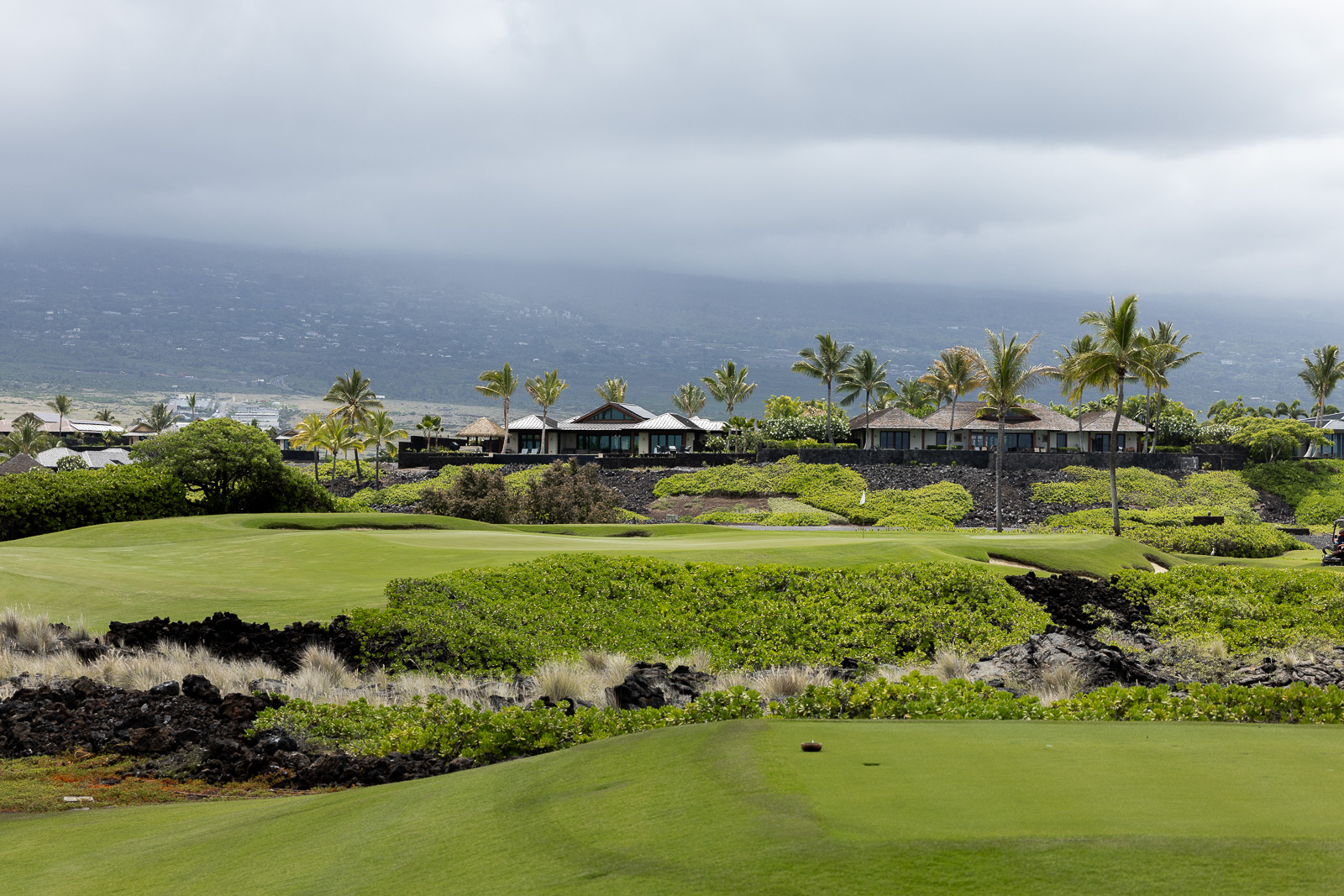
The green is one of the most undulating on the course, and there are a number of sucker pins just begging you to take an ill-advised aggressive line.
Both times I played the hole I made a par, which felt like a significant accomplishment given the pin we had.
The good news is that if you don’t fare well here, then the last of 3 “Golf Hale” comfort stations is waiting there to console you.
These are one of the most unique, impressive, and enjoyable experiences while playing Kohanaiki – we’ll talk more about them in a minute.
14 may have been my favorite golf hole on the course.
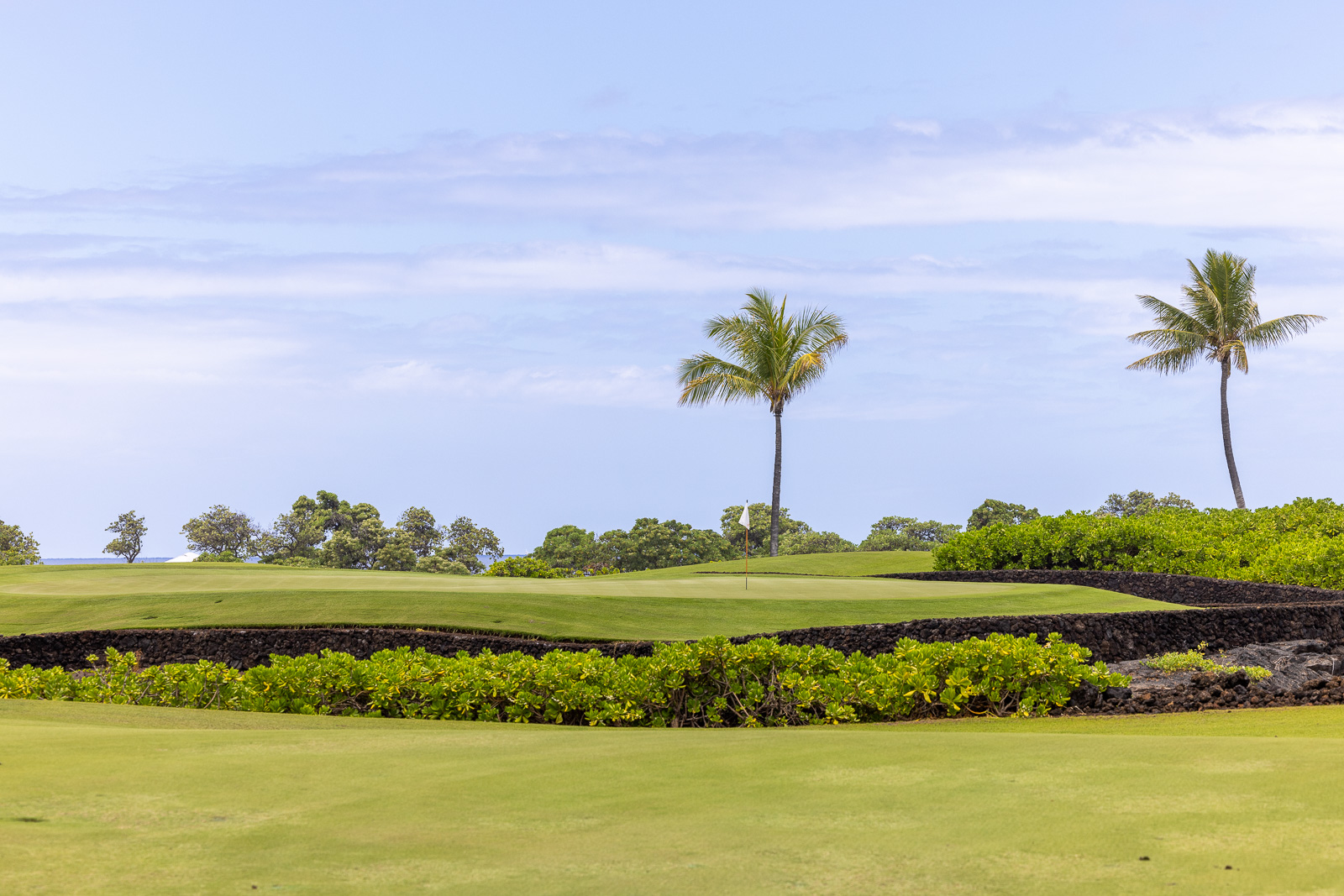
This is another short par 4, but you’d have to be very ballsy to try and drive the green.
The hole weaves through “anchialine ponds” which are a signature of the land. This is a unique water eco-system where water forms pools among lava rock – making for unique visuals and experience.
The green is one of the largest on the course, and is guarded by one of these ponds. On the surface, it doesn’t seem like too tough of an approach. But between the distracting view and the size of the green, if you’re not close to the pin, a 3 putt is definitely on the table.
Oh, one other thing.
Did I mention the lava rock bunker??
Yep. It’s one of the most unique hazards I’ve ever seen on a golf course. And it’s just one of many historical sites dotting the course and property. Hit your ball in there? Don’t even try to get it. Take your drop and move on.
Hole 15 feels like 14 on steroids.
More lava rock. More anchialine ponds. Trickier drive.
Another wonderful green.
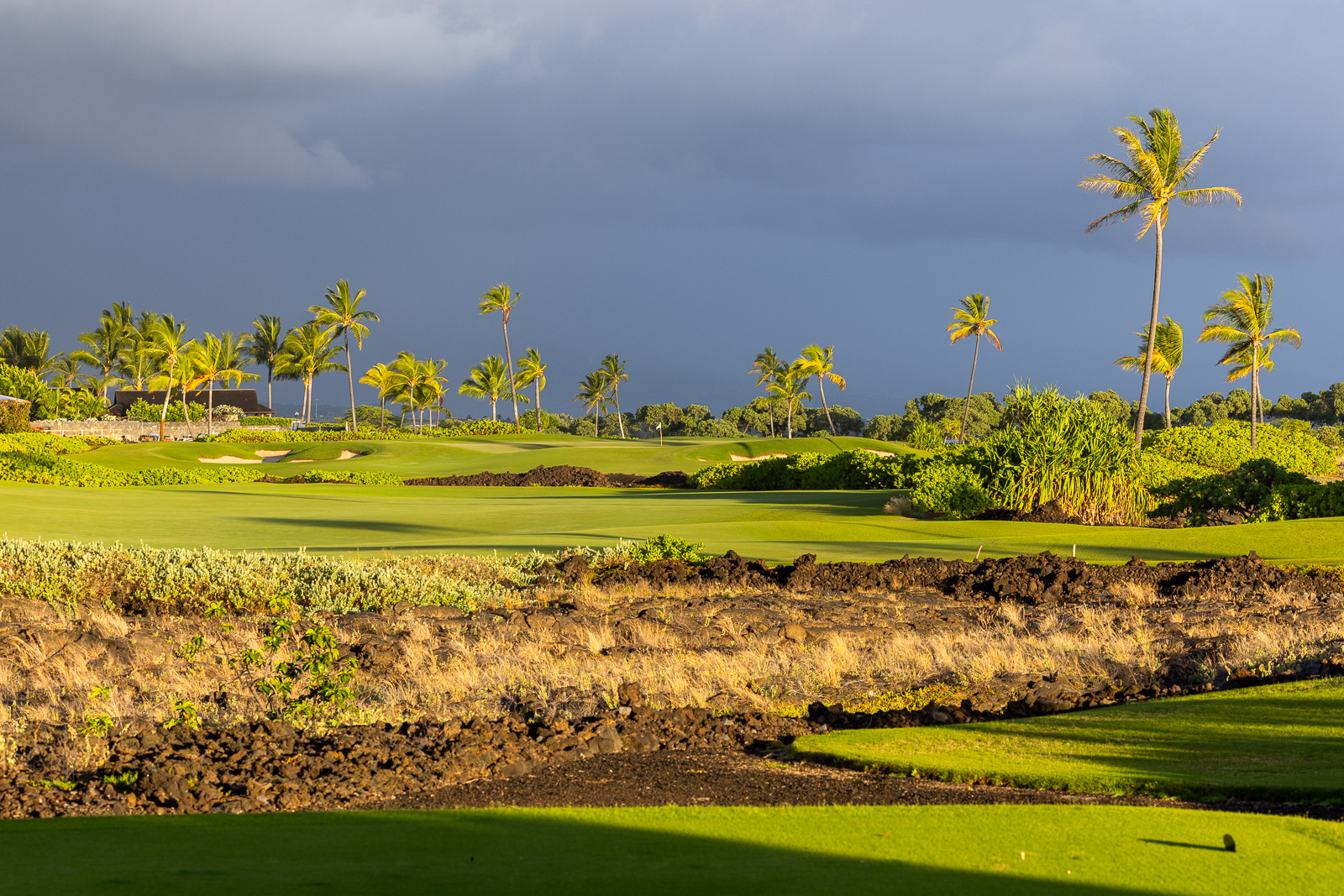
The 16th is the final par 3, and this is Director of Golf Lehua’s favorite hole on the course.
Kind of hard to argue. It’s a spectacular par 3. Don’t mess with anything down the right hand side. If you need to bail out, go to the left.
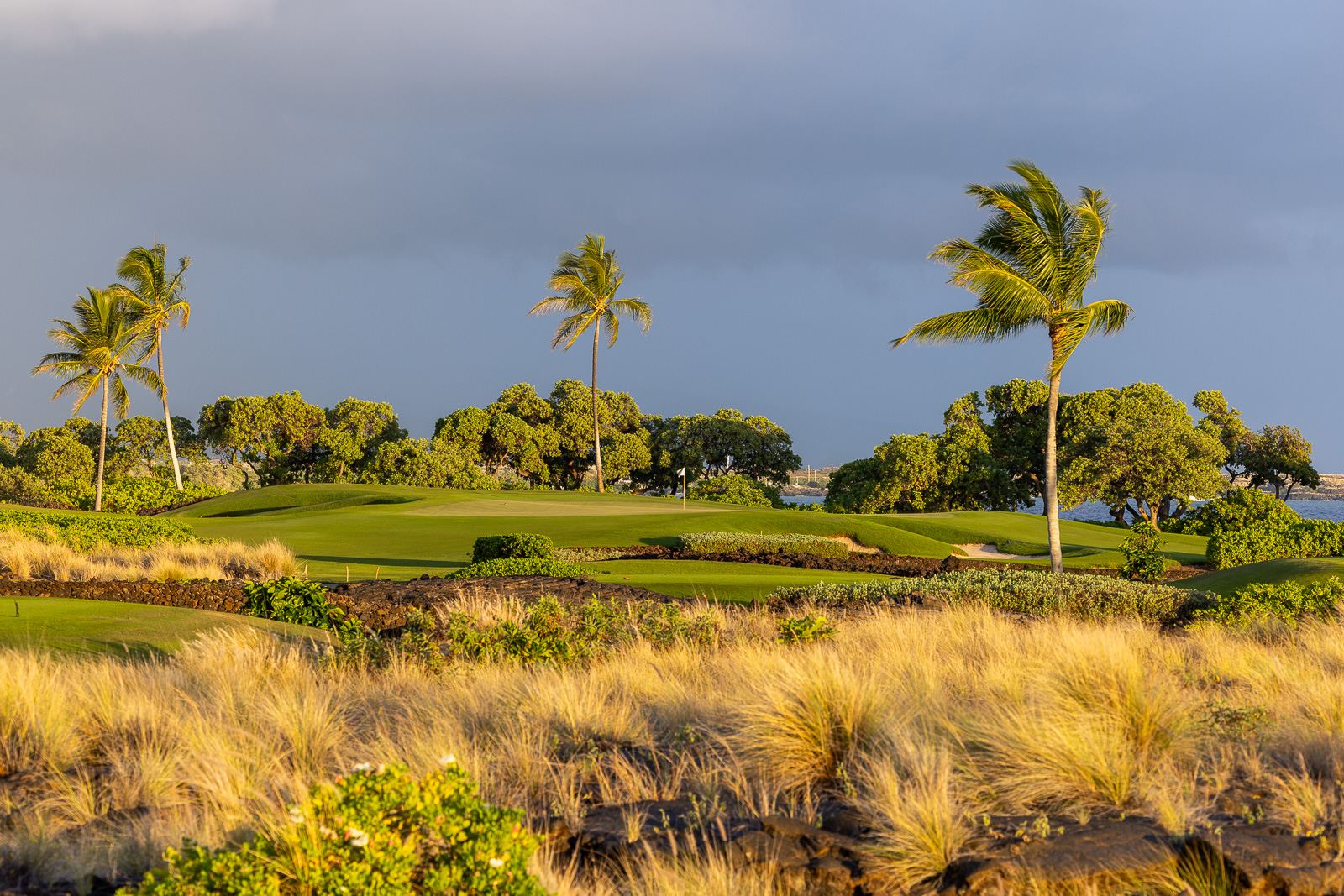
17 is a wild par 5, that takes a few plays to really get a sense for what the hole does.
One unique feature is you drive it straight over the historic Donkey Corral. For centuries locals would take their donkeys down from their villages on the mountain and other sides of the island to catch fish and trade with others. The story goes that the donkeys were so well trained, they didn’t even need a human to guide them.
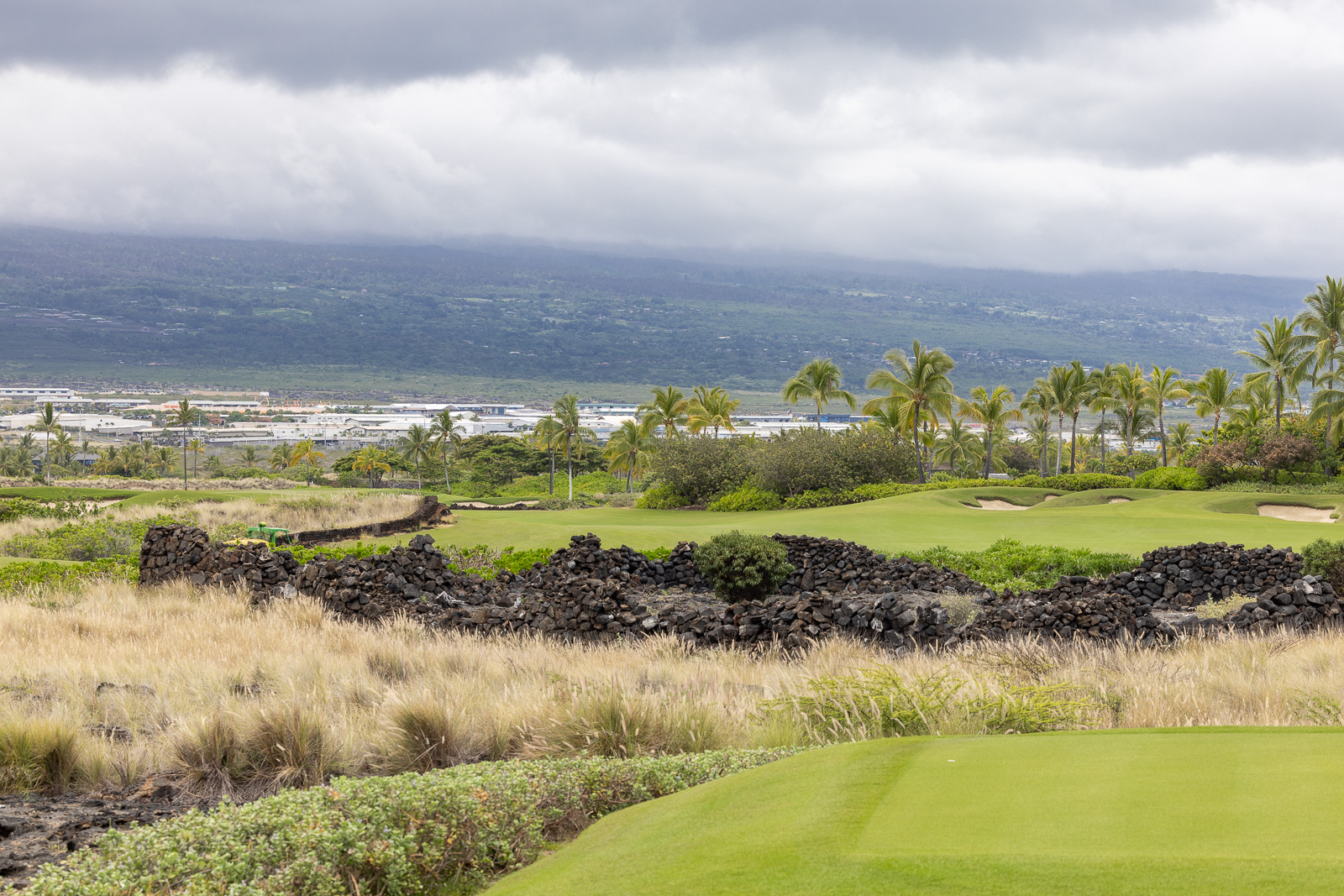
This is one of the dozens of historic spots on the property, and it’s wonderful to see the developers put so much thought into preserving the history of the land so well.
18 is a beast of a finishing hole. It finishes back up towards the clubhouse, and requires two very well-struck shots to have a chance to make your par.
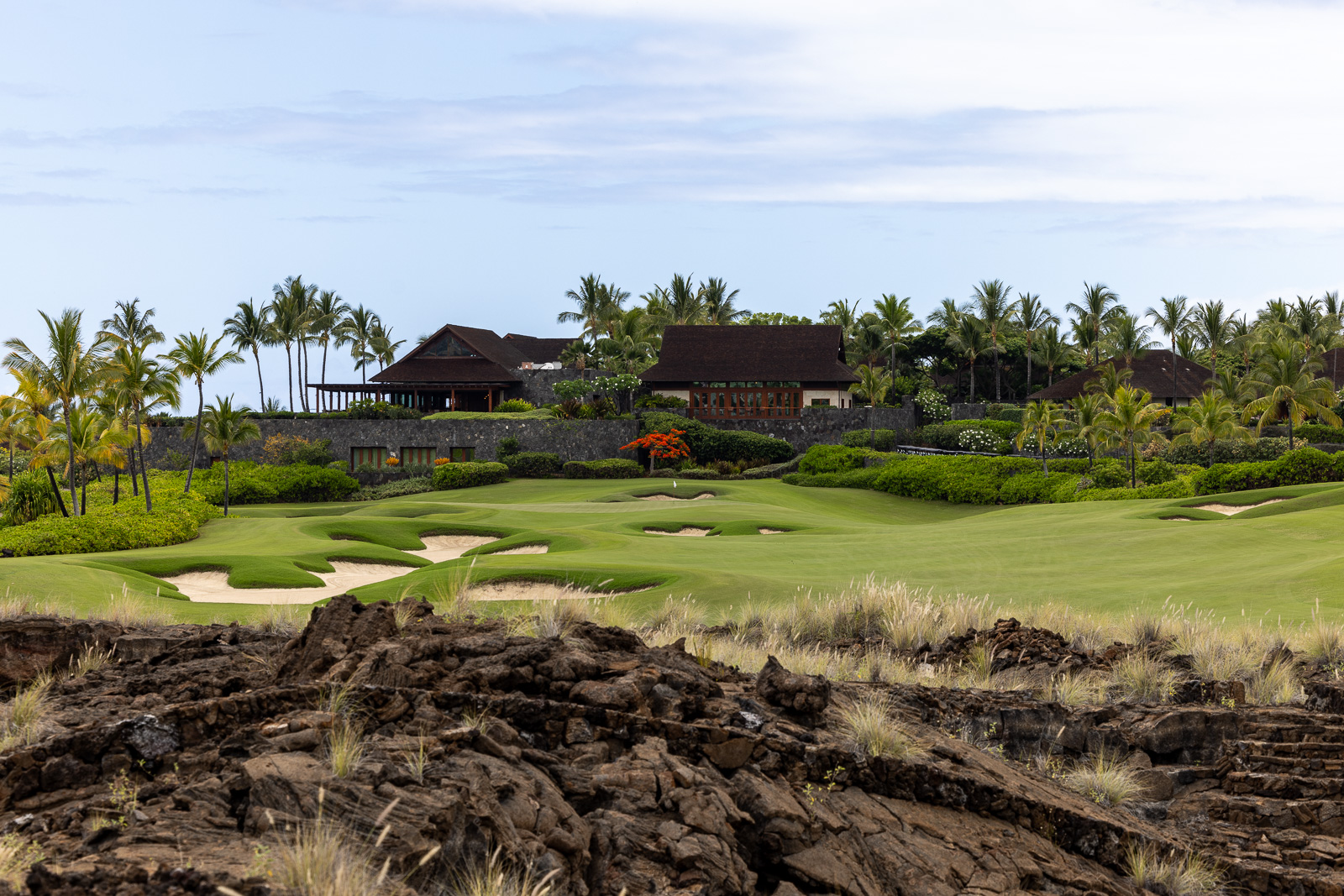
During my initial round, I ended up in the swale off the right side of the green known as “Mochi Valley.” In the early years of the club, an attendant would meet you here after you holed out and provide you with a cold towel and a mochi ice cream ball.
I was very pleased to make it up and down for my par, amidst claps from a few people on the balcony outside the pro shop perched above the green.
I was even more pleased to be delivered a towel and mochi when I got back up to the pro shop 🙂
The Wonderful “Golf Hales”
It’s one of the most elusive and wonderful amenities you can find on a golf course: the comfort station.
Some places, like Quivira, feature insane views. Other spots like Gozzer Ranch, have an unbelievable selection of snacks and drinks.
At Kohanaiki, you’ll find both. (Although I suppose that could be said for the aforementioned courses as well!)
You’ll find 3 comfort stations or “Golf Hales” across the course.
Each one has its own unique sampling of items, but all of them are among the most well-stocked comfort stations you’ll ever find on a golf course.
Each Golf Hale has its own personality, as well.
There’s the Hale off of #7 tee, which happens to be right by the tennis and pickleball courts.
Here you’ll find some more family-friendly options like an ice cream machine (with plenty of toppings), Gatorade, juice, beers, chips – the list goes on.
There’s one off 6 tee that also serves the driving range. Here you’ll find a wide assortment of local Hawaiian snacks, plus a margarita machine. Not to mention bottles of Grand Marnier and Cointreau for your traditional margarita float 🙂
When you get to 13 green you’re treated to the “Sunset” hale. Here you’ll find local beef jerky, sandwiches, salads, a delicious taquito-like snack that comes in different flavors, and most importantly, the mai tai machine.
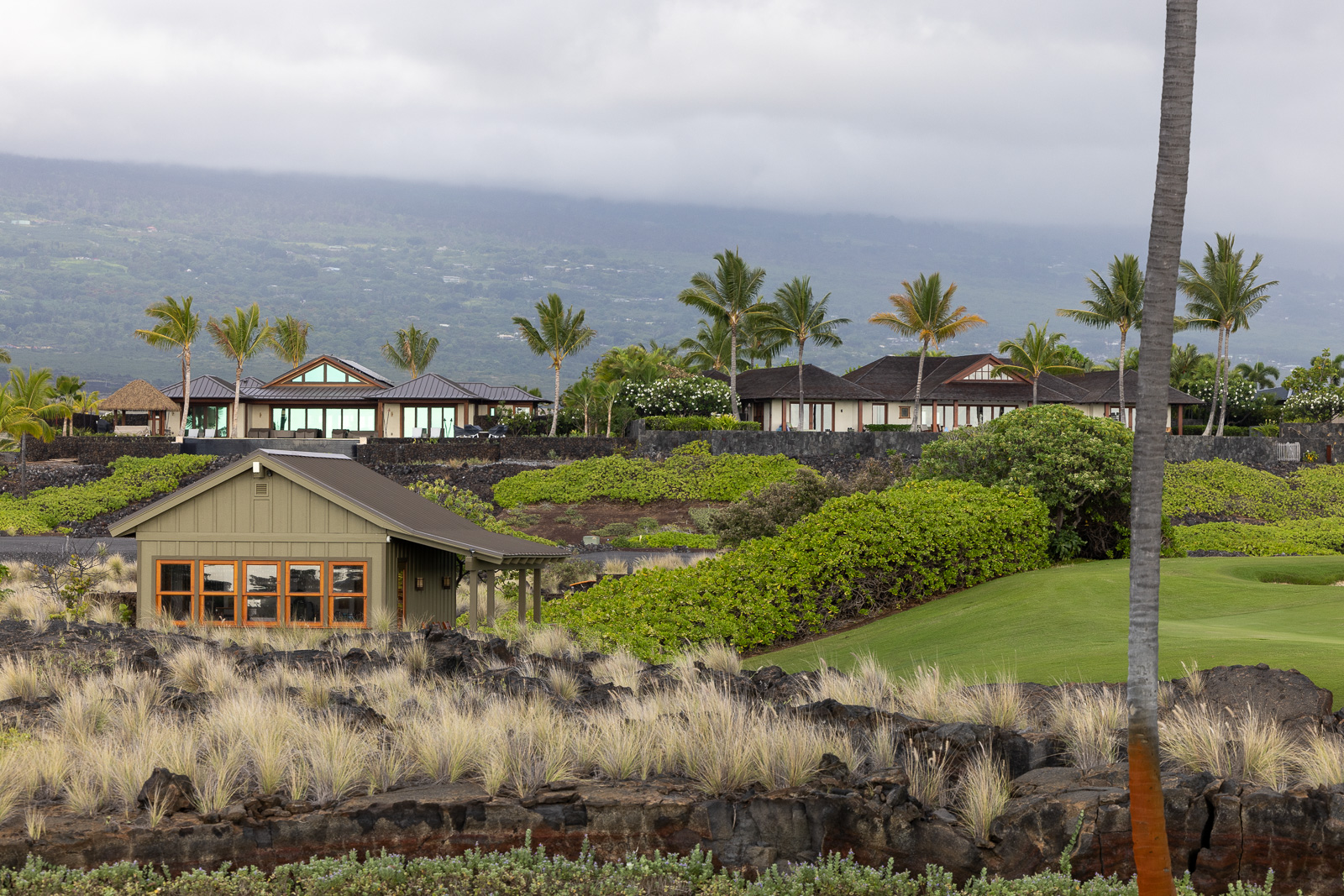
This is a favorite spot of the members to bring their carts out in the evenings to enjoy a beverage and the sunset over the ocean.
The best part about these Hales? They’re available to members at any time. In the mood for a post-tennis margarita? Just hop on over.
Kids wanna run out and grab some free ice cream? Great, c’mon in!
The only caveat to this is the Sunset Hale over on 13 becomes unlocked for non-golfers at 5pm.
I wanted nothing more than to try every snack, and every drink at these comfort stations. But during the 3 days I was there, I barely made a dent.
Final Thoughts on the Golf Course at Kohanaiki
I honestly didn’t really know what to expect before my trip to Kohanaiki. Now that I’ve been home for a few days, I find myself continuing to think about what an impressive experience the whole place provides.
I personally loved the golf course.
The generous fairways made the course feel very playable, while giving you a fighting chance if you’re not striking the ball as well as you’d like.
Yet, there’s enough challenge with the fairway bunkering and lava to still make you think on every tee shot.
The course has wonderful short par 4s which I really enjoyed, and the finishing 6 holes are among the best finishing stretch of golf I’ve played.
Between the world-class comfort stations, and a course that rarely (if ever) feels crowded, the experience here is something truly special.
If the golf course stood alone without the club, it would be well worth a visit to come play it.
But considering everything else that you get while a member or guest at Kohanaiki? It truly makes it one of the most special, world-class facilities I’ve ever experienced – or expect to experience, in my life. If you’re looking to play golf someplace a little more accessible in Kona, definitely check out Hualalai Golf Course at the Four Seasons Hualalai Resort.
Have you played golf at Kohanaiki? What did you think?
Want more? Here’s my full recap of Kohanaiki Club.

